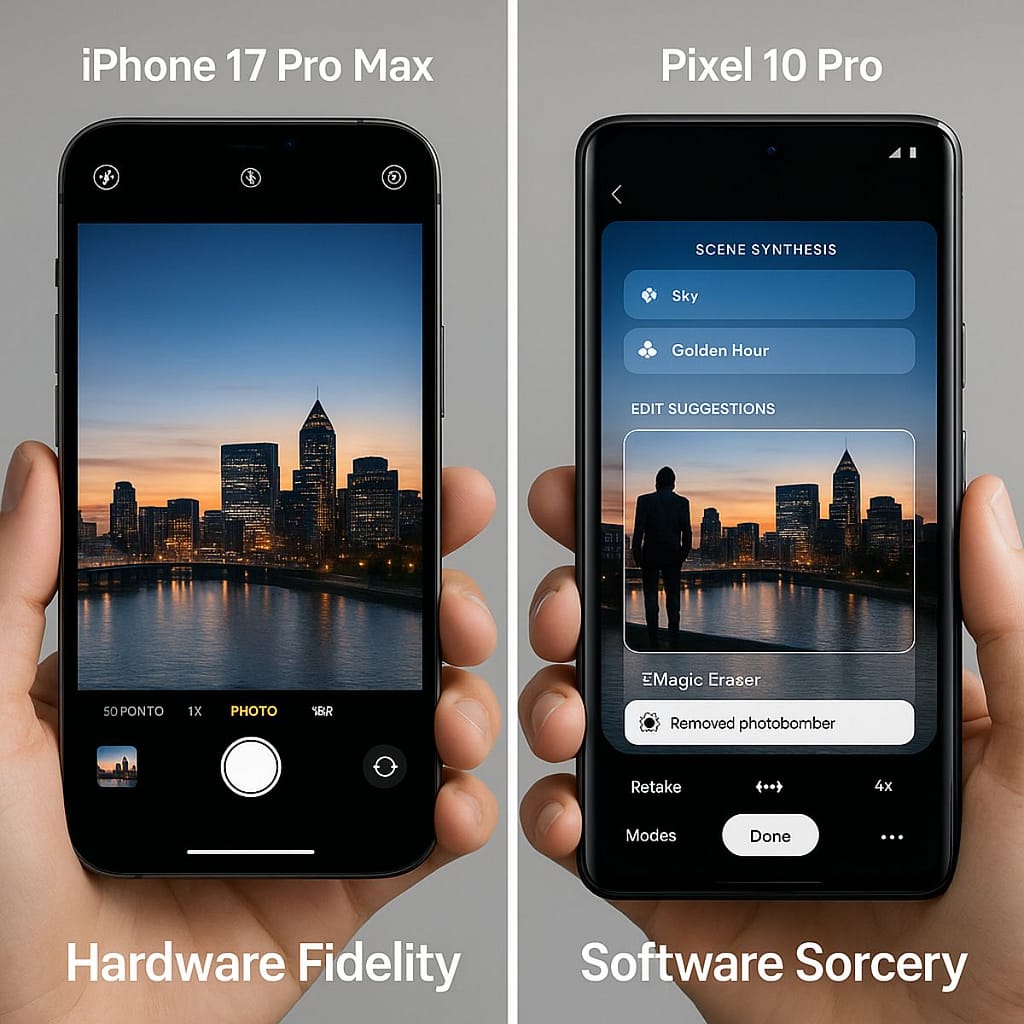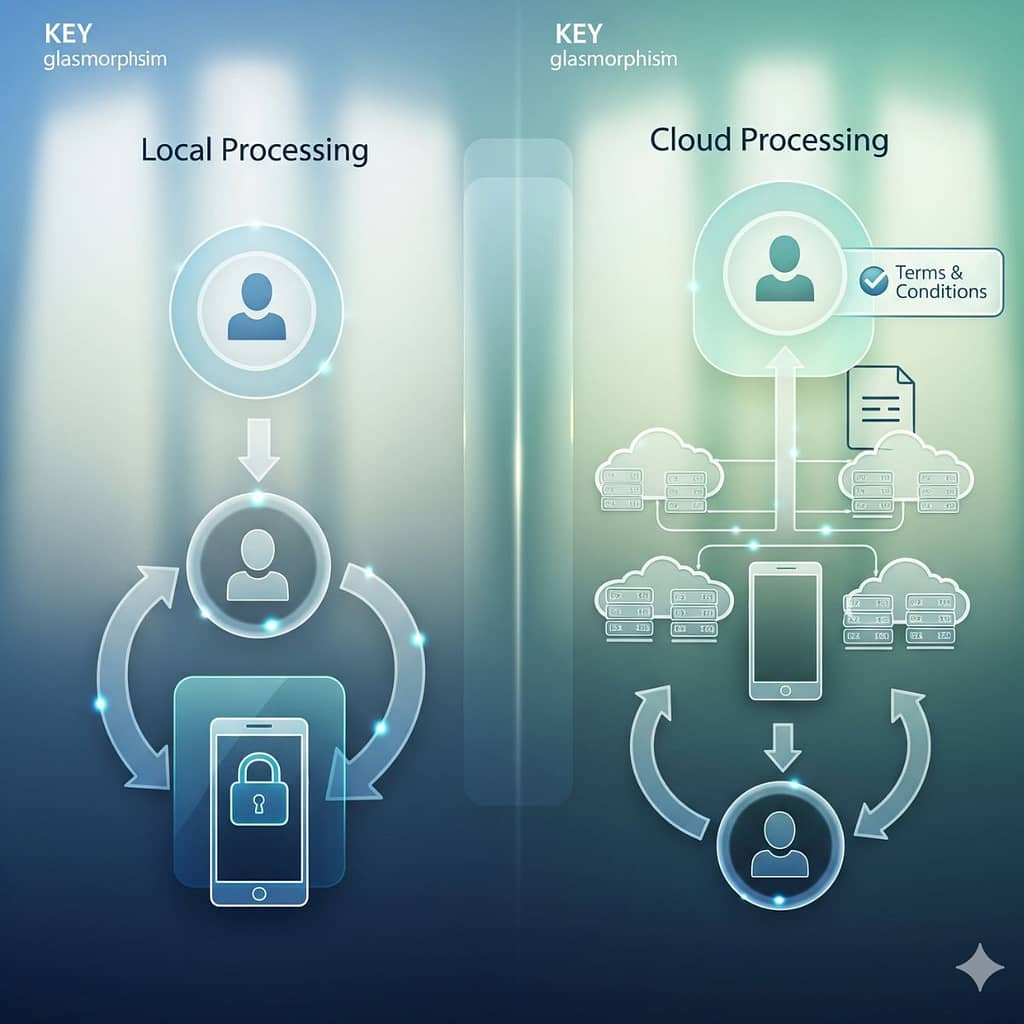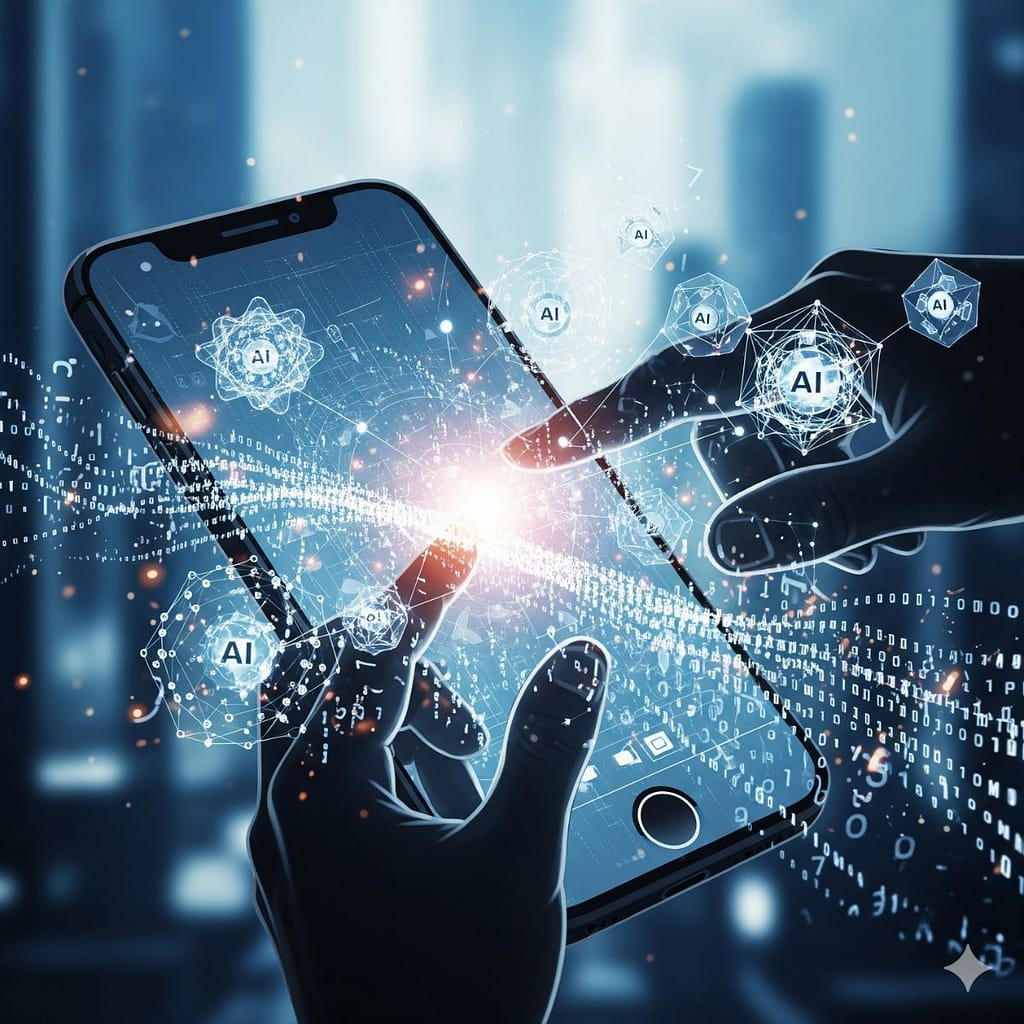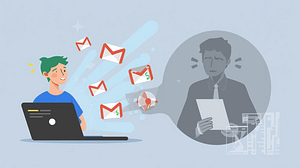Future of Smartphone AI The battle between the iPhone 17 and Pixel 10 is forging the future of smartphone AI, creating a fundamental schism between on-device AI processing championed by Apple and Google’s cloud-first vision. This cloud AI vs local AI debate is ultimately a referendum on AI smartphone privacy, pitting the raw power of Google Gemini AI against the seamless security of Apple Intelligence.
This clash of titans isn’t just theoretical; it’s already playing out in this year’s flagship models. For a raw, spec-by-spec comparison of how these philosophies translate into actual devices, check out our detailed spec-by-spec breakdown of the Pixel 10 Pro and iPhone 17 Pro Max.
Check our detailed spec-by-spec breakdown
How the iPhone 17 and Pixel 10 Forge Two Different Paths to a Smartphone AI Future
The battle between the iPhone 17 and Pixel 10 represents more than just competing products—it reveals a fundamental philosophical schism in how tech giants envision the future of smartphone AI. We’re witnessing the emergence of two distinct technological religions: Apple’s doctrine of integrated hardware sovereignty versus Google’s gospel of cloud-first artificial intelligence. This clash will define our digital lives for the next decade.
The Great Divorce: On-Device Intelligence vs. Cloud Computation
The core of this philosophical split lies in processing location. Apple’s on-device AI processing approach with the A19 Bionic chip represents the culmination of their vertical integration strategy. Every AI operation—from photo enhancement to language processing—happens locally on the device. This architecture prioritizes several key advantages:
- Instant response times with no network latency
- Enhanced privacy as personal data never leaves the device
- Reliable functionality regardless of internet connectivity
- Optimized power efficiency through hardware-software integration
Apple’s doctrine is embodied in the iPhone 17 and its powerful A19 Bionic chip, designed to handle sophisticated on-device AI processing. To see the full scope of its hardware capabilities, read our article covering everything we know about the iPhone 17 series.
Check everything we know about the iPhone 17 series
Conversely, Google’s cloud AI vs local AI hybrid model with Tensor G5 represents a fundamentally different approach. While some processing occurs on-device, the most complex AI operations leverage Google’s massive cloud infrastructure:

- Access to more powerful AI models than can fit on a device
- Continuous improvement as models update server-side
- Cross-device intelligence that remembers context across platforms
- Broader knowledge base drawing from Google’s extensive data resources
This technical distinction represents the modern manifestation of the classic closed vs. open ecosystem debate that has defined these companies for decades.
The Privacy Paradigm: Security Versus Capability
The most significant implication of this architectural split concerns AI smartphone privacy. Apple’s approach inherently protects user data by keeping it on the device. The company has positioned itself as the privacy-focused alternative, leveraging this distinction as a competitive advantage in markets where data protection is increasingly valued.
This isn’t just a theoretical concern a recent Stanford University study on the ethics of cloud AI highlights the significant energy consumption and potential for embedded bias in large-scale models, concerns that are mitigated by Apple’s on-device approach.
Google’s model requires data transmission to cloud servers for processing, creating potential vulnerability points and raising questions about data usage. While Google has implemented numerous privacy protections, the fundamental requirement of data exchange creates a different risk profile.

This privacy dichotomy represents perhaps the most meaningful choice consumers will make: whether to prioritize absolute privacy or maximum AI capability. There’s no objectively correct answer only what matters most to individual users.
The Ecosystem Evolution: How AI Will Transform Everything
The implementation of Google Gemini AI and Apple Intelligence will fundamentally reshape how we interact with our devices:
The App Interface Revolution
We’re moving toward agent-based interfaces that anticipate needs rather than responding to commands. The traditional app grid will become increasingly secondary to AI-driven interactions that happen through natural language and contextual awareness.
The Specialized Hardware Imperative
Apple’s approach requires increasingly specialized hardware. The A-series chips have evolved from general-purpose processors to AI-optimized systems with dedicated neural engines. This hardware specialization creates significant competitive advantages that competitors cannot easily replicate.
The Connectivity Conundrum
Google’s vision depends on ubiquitous connectivity. While 5G (and eventually 6G) enables this approach, it creates limitations in areas with poor connectivity and introduces subscription service dependencies that may prove exclusionary.
The Next Battlegrounds: Where This War Will Be Fought
Several emerging fronts will determine which approach ultimately prevails:

The Energy Efficiency Equation
As AI features become more pervasive, their energy consumption becomes increasingly important. On-device processing offers power efficiency advantages, but cloud processing centralizes computational loads that might ultimately prove more energy efficient at scale.
The Regulatory Landscape
Privacy regulations like GDPR and emerging AI legislation may significantly impact both approaches. Stricter data transfer regulations could advantage Apple’s model, while restrictions on device-level AI might benefit Google’s architecture.
The Business Model Conflict
Apple’s approach reinforces their hardware premium model, while Google’s approach strengthens their services and advertising business. The ultimate victory might belong to whichever company can most effectively monetize AI capabilities.
The Custom Silicon Race
The effectiveness of on-device AI depends heavily on custom silicon development. Apple’s significant lead in this area provides them a substantial advantage, forcing competitors to either match their investment or concede the high-performance on-device AI market.
The Verdict: Which Vision Will Prevail?
The truth is that both approaches will likely coexist and even converge over time. We’re already seeing elements of this synthesis:
- Apple increasingly incorporates cloud elements while maintaining privacy protections
- Google develops more capable on-device AI while maintaining cloud connections
- Both companies are developing hybrid approaches that balance the strengths of both models
The real winners will be consumers who benefit from this competitive innovation. Rather than one approach defeating the other, we’re likely to see a stratification of the market:
- Privacy-sensitive users will gravitate toward Apple’s approach
- Capability-seeking users will prefer Google’s implementation
- Enterprise markets will likely adopt segmented approaches based on use case
- Developing markets might favor different implementations based on connectivity infrastructure
The future of smartphone AI isn’t a single path—it’s a branching tree of possibilities shaped by these competing visions. The iPhone 17 and Pixel 10 don’t represent the endpoint of this journey, but rather crucial milestones in the defining technological evolution of our decade.
This philosophical war between integrated hardware and cloud intelligence is just beginning. If you’re just catching up on this debate, you can start with our initial comparison of these competing visions that started it all.
Initial comparison of these competing visions
What’s your take on the future of smartphone AI? Are you Team On-Device or Team Cloud? Share your thoughts in the comments below.







